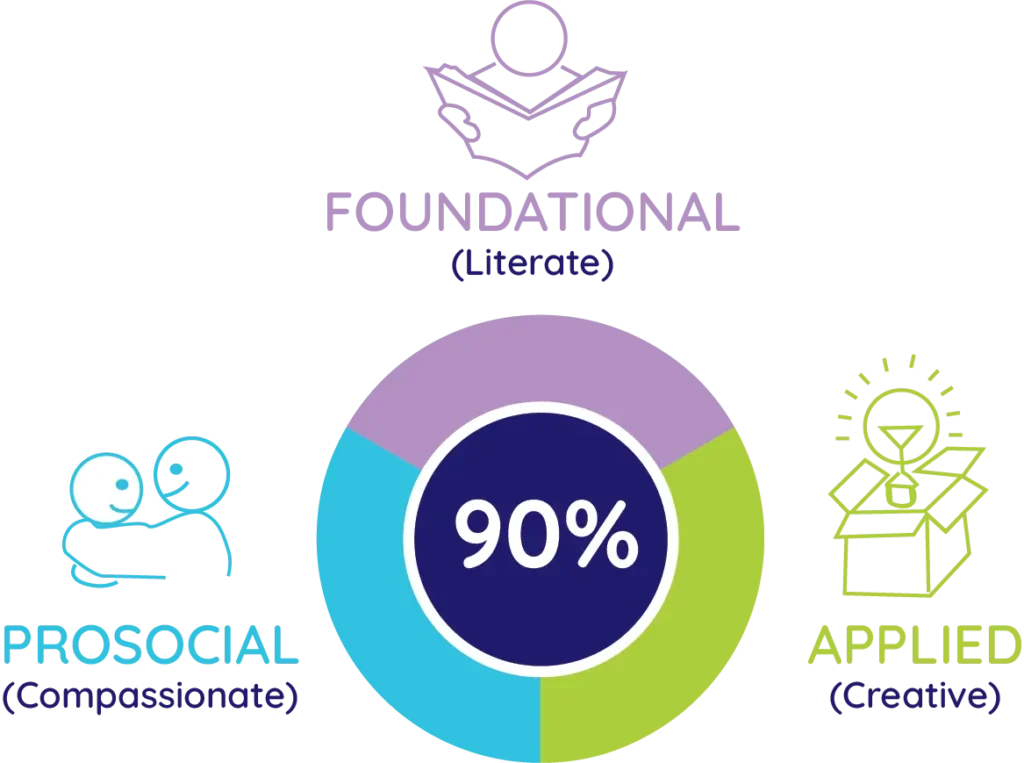ENRICHED LITERACY FRAMEWORK
Overview
The Enriched Literacy framework is a comprehensive, integrated approach to learning that strengthens the prosocial skills of students so that they can better learn the foundational literacy skills they need, while providing authentic, purposeful opportunities for those skills to be practiced and applied.

Prosocial Literacy:
How do we create the conditions in which students are safe and available to learn?
Foundational Literacy:
What are the essential skills students need to learn to be able to read?
Applied Literacy:
How do we create authentic opportunities for students to show what they know and apply their learning?
Aligned with the Science of Reading, informed by best practices in Direct and Explicit Instruction, and embracing a Structured Literacy approach, the Enriched Literacy Framework is a way to think about learning to read that can reach all learners on the journey to our Moonshot Goal of 90% literacy by the end of 3rd grade.
How can we help educators better understand and support the learning journey our children are on to become literate?
Our goal with these resources is to demonstrate what Enriched Literacy might look like in action, and to share with you how it works, how it can transform your practice and support your students.
Enriched Literacy can work with any curriculum, because it is learner centered, meeting students where they are to best move them forward, and to help them become compassionate, creative, and literate citizens who will improve our world. Welcome to the journey!
PROSOCIAL LITERACY
We define Prosocial Literacy as the ability to manage emotions and navigate group interactions to build a community of learners. We ask: How do we create the conditions in which students are safe and available to learn?
We know students need to be safe and connected to be able to learn effectively, and we know teachers never have enough time in the day to cover all the necessary content. We also know that students need to feel like they matter and that their voices are represented in the classroom before they will engage in the hard work of learning. Prosocial skills include managing emotions, setting goals, developing empathy and positive relationships, and making responsible decisions. We bring literacy into the mix; by intentionally integrating concepts and content into rituals and routines designed to create psychological safety, you can help students see the purpose and relevance of what they are learning, and you can make effective and efficient use of every moment of your day.
FOUNDATIONAL LITERACY
Foundational Literacy is the ability to read words and bring meaning to text. What are the essential skills students need to learn to be able to read?
If we define literacy as the ability to read, write, speak and communicate, there can be no more fundamental set of skills for student success. Students need to first crack the code that makes sense of letters and sounds, and then they can begin to make meaning of words and text. Once students have gained this “alphabetic insight,” and they start to understand the patterns of our language, they then need ample opportunities to practice reading and writing to grow vocabulary and improve fluency. Once they can pull print off a page and begin to unlock the meaning of words, students are on a path to becoming readers and life-long lovers of learning.
APPLIED LITERACY
Applied Literacy is the ability to apply skills and knowledge gained to authentic, real-world contexts. We want to explore: how can we create authentic opportunities for students to show what they know and apply their learning?
How often do you hear students ask “WHY do we have to do this?” Why, indeed. We look for ways to make learning purposeful and relevant for students. Students need ongoing and embedded opportunities to apply what they are learning so that they can see WHY they are learning it. When learning to read, not only do they need to practice reading, they need to see that literacy is in service of something. This can be done through hands-on, experiential learning, like what you might find in Project- or Problem- Based Learning, Environmental Education, and Arts Integration. STEM/STEAM/STREAM programs that integrate science, technology, engineering, math and even reading and the arts, can also help make learning engaging and exciting for students. Whatever approach you choose, the key is to not lose sight of our fundamental objective: to help students learn to read, so that they can create, innovate, and become literate citizens who will improve our world.
